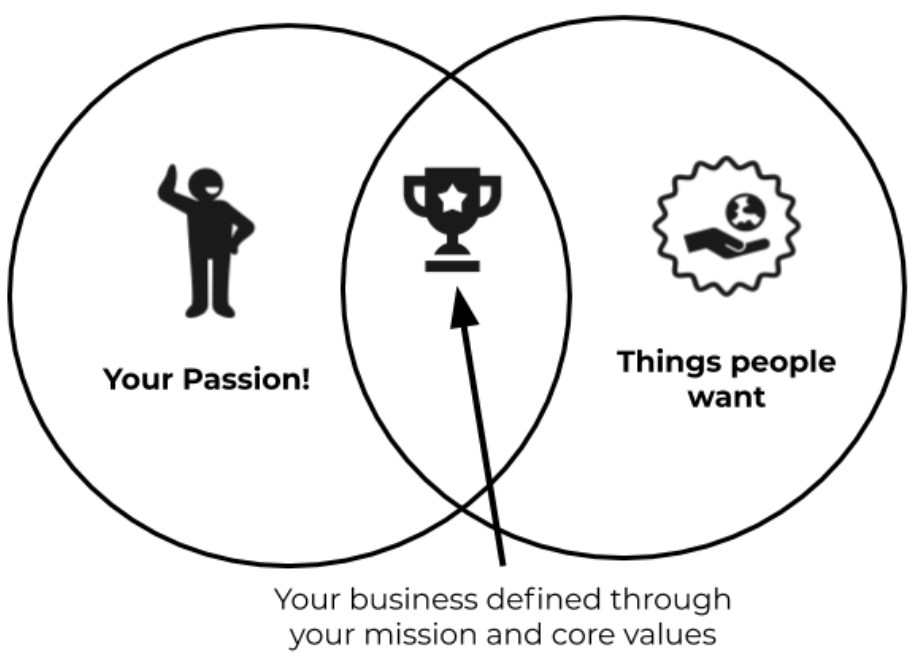Make Things People Want!
On average, there are 30,000 consumer products introduced each year in the United States alone. For perspective, that’s over 80 new products introduced every day! So why are we still so confident about launching a consumer packaged good (CPG) in the food space?
At Union Kitchen, we believe successful food businesses separate themselves by creating a product that reflects the entrepreneur’s passion and what people want.
.png)
Let’s use the diagram above to explore this concept in greater detail. We need to understand passion and things people want so that we can find the intersection between the two.
Passion
Passion is where everything starts. You are going to have to work insanely hard to build your business. There are going to be long nights, ups and downs, and everything in between. All of this needs to be fueled by your passion. If you don’t believe in the product or what you are doing, neither will your consumers and you won’t be in business for very long. “At the most basic level, that’s the whole reason to start a business. You see an opportunity to make the world a better place by making a great product and something that makes you proud,” Michael Haft, Co-Founder of Compass Coffee shared with us as he talked about his passion for coffee and community.
Make Things People Want
This sounds great but how do you know what people want? This is a combination of art and science. We approach this by (1) Know the Pain Point, (2) Go to the Store, and (3) Talk to Customers.
#1. Know the Pain Point
A pain point is the specific problem the consumer is facing. For example, an easy one we can all relate to is hunger. Think about that 3pm hunger hit when you know you shouldn’t snack but you really want to. Samy, the founder of Snacklins, recognized he could offer a solution to this pain point by introducing a line of low-calorie puffed chips in fan-favorite flavors, including nacho and barbeque. He made something people wanted by addressing a pain point we are all familiar with.
Margarita, founder of M’Panadas, set out on a similar path. As a full-time professional and mother of 3, she felt pressed to use her time and resources as effectively as possible to keep things running smoothly. This meant finding healthy, quality meals for her family that didn’t take hours to prepare. Using her Colombian heritage and experience working in her father’s restaurants, Margarita launched a line of empanadas. Three years later, M’Panadas is a national brand meeting the pain point for customers who want to eat healthy on the go.
Milk Cult founders Ed and Pat started an ice cream revolution by updating everyone’s favorite novelty desserts (ice cream sandwiches, cones, etc.). They noticed the pain point that ice cream novelties have become boring and filled with chemicals. Milk Cult is now expanding nationally, offering innovative and epic ice cream novelties crafted from scratch with high-quality ingredients.
#2. Go to the Store
You can learn so much about what people want in your local food stores! Grocery stores are an incredible wealth of information for understanding what people want. There’s a reason stores dedicate entire aisles to frozen pizza and ice cream. People love frozen pizza and ice cream.
EAT Pizza is the perfect example of this in practice. Andy, EAT Pizza founder, found himself wandering the frozen section at his local Whole Foods. As a pizza nerd, he was immensely disappointed by the lack of quality he saw in the frozen pizza section. He wanted the convenience of take-home, frozen pizza WITH great taste. Recognizing the huge market for frozen pizza, Andy developed a frozen pizza that tasted great and was convenient.
Try this out for yourself. Walk into your nearest grocery store and look at how much space is dedicated to your product category. Is it one bottom shelf? Is it an entire aisle? The answer is a strong signal towards what customers want.
#3. Talk to Customers
What’s more practical than asking people what they want? Answer: Nothing.
Every conversation and interaction you have with customers is a data point. You get to understand what they think of the flavor, the color, the texture, etc. Collectively, this gives you a picture of what they want.
Just ask Michael and Harrison, the founders of Compass Coffee, “Our customers helped show us the path. Every day, working behind the bar, we asked our customers questions. ‘What do you think about this coffee? What would you like to see differently? What do you really like that we should keep doing?’’ Today, Compass Coffee has 12 cafe locations and is opening a 50,000 sq. ft. roastery facility.
Finding the Intersection
A successful food business reflects the intersection between your passion and what people want. This is a formula we’ve seen play out time and time again in our brands and the world’s most successful brands. Patagonia founder Yves Chouinard was a blacksmith by trade, a lifelong climber/adventurer, and cared deeply for the environment. Through his personal passion, he identified the climbing community’s pain point: a lack of quality, reusable climbing gear. Yves developed his own gear through his experience as a blacksmith that meet this need. Fast forward to today and Patagonia continues to solve pain points for their customers.
Jeni’s Ice Cream founder Jeni Britton Bauer similarly found the intersection between her passion and what people want. Her passion? Smells! What people want? Delicious ice cream. Jeni built an ice cream empire around the sensory experience -- from the flavors of her ice cream to the experience in stores.
Part of what makes entrepreneurship so amazing is that it is rooted in passion, enough passion to make someone want to turn this obsession into their life’s work. What makes entrepreneurs successful is combining that passion with making something people want.

Comments